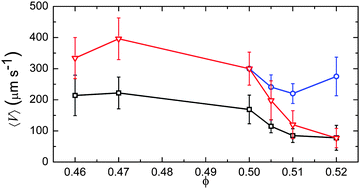We investigated the pressure driven flow of concentrated colloidal dispersions in a converging channel geometry. Optical microscopy and image analysis were used to track tracer particles mixed into dispersions of sterically stabilized poly(methyl methacrylate) (PMMA) spheres. The dispersions were drawn into a round 0.5 mm capillary at one of two pump speeds (![[triple bond, length as m-dash]](https://www.rsc.org/images/entities/char_e002.gif) applied pressure): v1 = 0.245 ml min−1 and v2 = 0.612 ml min−1. We observed that the dispersions at particle volume fractions ϕ ⩽ 0.50 followed Hagen–Poiseuille flow for a simple fluid; i.e. the mean flow rate 〈V〉 is approximately proportional to pressure drop (pump speed) and inversely proportional to viscosity η. Above this concentration (ϕ
applied pressure): v1 = 0.245 ml min−1 and v2 = 0.612 ml min−1. We observed that the dispersions at particle volume fractions ϕ ⩽ 0.50 followed Hagen–Poiseuille flow for a simple fluid; i.e. the mean flow rate 〈V〉 is approximately proportional to pressure drop (pump speed) and inversely proportional to viscosity η. Above this concentration (ϕ ![[gt-or-equal]](https://www.rsc.org/images/entities/char_2a7e.gif) 0.505), the dispersions exhibit granular-like jamming behaviour with 〈V〉 becoming independent of the pressure drop. However, at the highest applied pressure (v2), the dispersions are able to unjam and switch from granular-like behaviour back to a simple hard-sphere liquid like system, due to the formation of rotating vortices in the spatial flow pattern. This mechanism is consistent with computer simulations of granular systems and supports for example proposed explanations of anomalously low friction in earthquake faults. We also link this behaviour with the concept of fragile matter (M. E. Cates, J. P. Wittmer, J. P. Bouchaud and P. Claudin, Phys. Rev. Lett., 1998, 81, 1841–1844).
0.505), the dispersions exhibit granular-like jamming behaviour with 〈V〉 becoming independent of the pressure drop. However, at the highest applied pressure (v2), the dispersions are able to unjam and switch from granular-like behaviour back to a simple hard-sphere liquid like system, due to the formation of rotating vortices in the spatial flow pattern. This mechanism is consistent with computer simulations of granular systems and supports for example proposed explanations of anomalously low friction in earthquake faults. We also link this behaviour with the concept of fragile matter (M. E. Cates, J. P. Wittmer, J. P. Bouchaud and P. Claudin, Phys. Rev. Lett., 1998, 81, 1841–1844).

You have access to this article
 Please wait while we load your content...
Something went wrong. Try again?
Please wait while we load your content...
Something went wrong. Try again?
![[triple bond, length as m-dash]](https://www.rsc.org/images/entities/char_e002.gif) applied pressure): v1 = 0.245 ml min−1 and v2 = 0.612 ml min−1. We observed that the dispersions at particle volume fractions ϕ ⩽ 0.50 followed Hagen–Poiseuille flow for a simple fluid; i.e. the mean flow rate
applied pressure): v1 = 0.245 ml min−1 and v2 = 0.612 ml min−1. We observed that the dispersions at particle volume fractions ϕ ⩽ 0.50 followed Hagen–Poiseuille flow for a simple fluid; i.e. the mean flow rate ![[gt-or-equal]](https://www.rsc.org/images/entities/char_2a7e.gif) 0.505), the dispersions exhibit granular-like jamming behaviour with
0.505), the dispersions exhibit granular-like jamming behaviour with 

 Please wait while we load your content...
Please wait while we load your content...